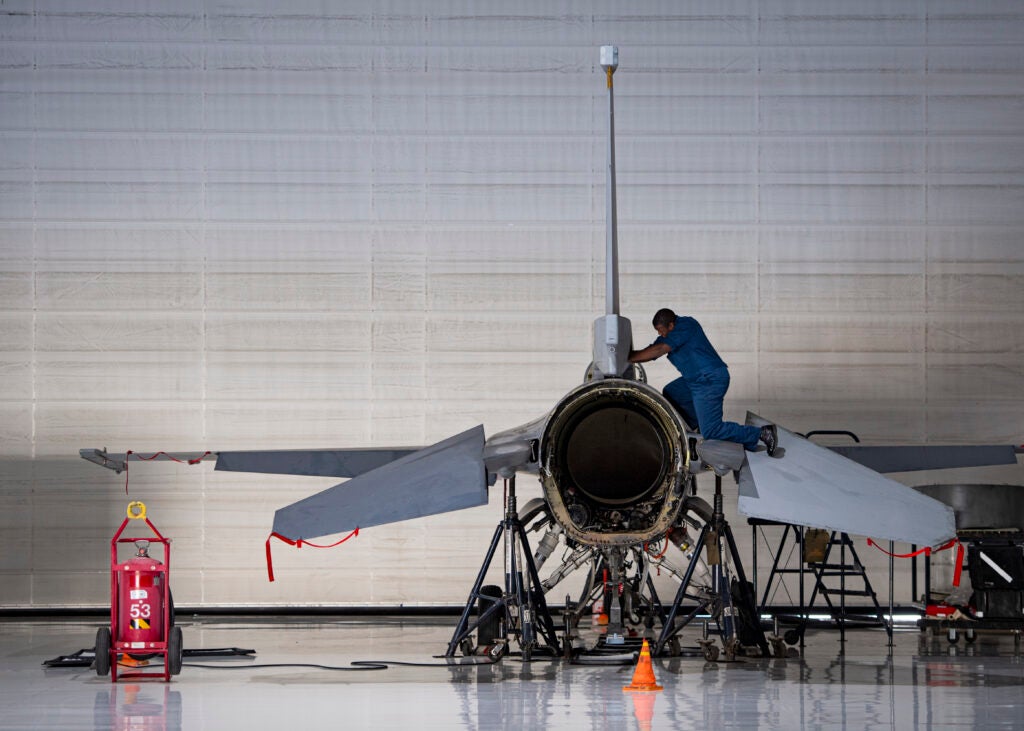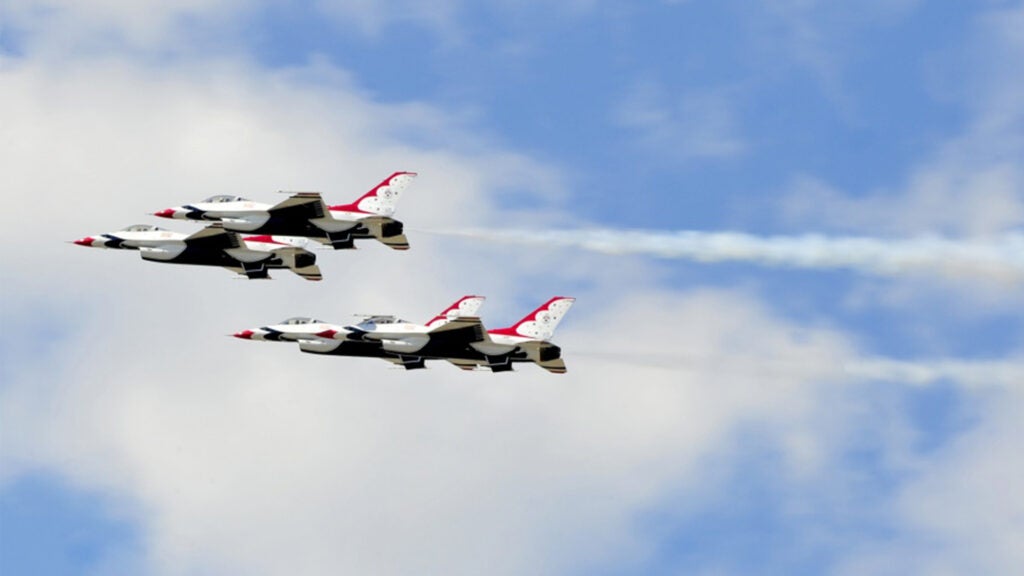What do the protagonists of The Princess Diaries, Pretty Woman, Miss Congeniality and Air Force F-16 tail number A91-0470 have in common? Well, they all went through intense makeovers to go from workaday beauties to runway queens, with pretty makeup to boot.
That’s right, F-16 tail number A91-0470, formerly of the U.S. Air Force Weapons School at Nellis Air Force Base, Nevada, recently became the newest member of the Air Force Thunderbirds, the branch’s premier aerial demonstration team. The aircraft, which we’ll just call 470, took its first flight in its new livery on May 5, just in time as the Thunderbirds get started on their 2021 airshow season, the first in two years since the 2020 season was largely cancelled due the COVID-19 pandemic.
While the transformation from grey-painted operational Viper into a red, white and blue Thunderbird did not involve a manicure or a trip down Rodeo Drive, it did involve a lot of hard work and brainpower from the Thunderbirds maintenance team. That’s because unlike prior conversions of operational F-16s into Thunderbirds, 470’s makeover took place entirely in-house at Nellis. Usually, the conversion happens at the maintenance depot at Hill Air Force Base, Utah. But the team decided to do it differently this year, said Capt. Mike Bell, the head maintenance officer for the Thunderbirds.
“The F-16s are going through major modifications throughout the fleet,” Bell told reporters on a press call on Friday. “We looked at that as an opportunity to give back to the combat units and say ‘hey, we won’t take up a depot spot, we can do it locally’ … The slots are definitely a scarce resource, so being able to give those slots back to the combat units was great.”

Like any other F-16 unit, the Thunderbirds have their own maintainers to keep the jets ready to fly. But major overhauls like the upgrades Bell is talking about usually take more advanced facilities and engineers like the ones at Hill. It’s kind of like trying to work on your car yourself rather than getting it done at the auto shop.
“Depot-level maintenance is a bit different than what we’re used to at the field level,” Bell explained. “A lot of the depot-level maintenance is conducted based on engineering drawings and very technical diagrams, as opposed to tasks that we do in the field that are generally written more like the owner’s manual in your car, like how to change a tire.”
The first step was for contractors who run the paint booth at Nellis to repaint the F-16 in the red, white and blue livery of the Thunderbirds. After that, they had to yank out the aircraft’s 20mm Gatling gun and the ammunition drum which feeds it, and then replace it with a smoke oil drum and plumbing system. When put together, that’s the system that allows a Thunderbird to shoot colored smoke out the back during an airshow.
While the maintainers and weapons experts at Nellis were certified to swap out the gun system with the smoke system, the team had to figure out for themselves how to install the cockpit controls for the smoke system. Setting that up involved Nellis electricians and avionics experts getting deep into the wired guts of the cockpit, but they worked it out eventually, Bell said.
The Thunderbirds team literally built part of the aircraft right there on base. The Thunderbirds require a very heavy metal bracket that goes where the gun barrels normally sit on the F-16. The bracket is heavy in order to help preserve the aircraft’s weight and balance as it flies, and it also keeps pressure on the aircraft’s smoke oil system so that it can still operate even when the F-16 is upside down. But it’s not the kind of hardware you can just pick up at Lowe’s.
Luckily, the 53rd Test and Evaluation Group at Nellis has a metal shop, and over the course of two weeks they milled a bracket out of a hunk of metal using a CNC machine on base.
“We put it in [the aircraft] and it worked great,” Bell said.
Despite this being their first time doing it, the Thunderbirds team converted the F-16 much faster than the maintenance depot at Hill. Normally, it takes the depot about 335 days to turn a regular F-16 into a Thunderbird, Bell said. But the Nellis team got it done in a mere 212 days, giving them a lot more time to take the aircraft out over the desert.
“It’s time that we get to use that aircraft and employ it that we would not have otherwise,” the captain said.

Bell added a vignette to the story: one of the newest Thunderbird maintainers, Staff Sgt. Jamie Smith, was the dedicated crew chief of the newly-converted F-16 when it was still at the Weapons School at Nellis. She joined the team about three months after the jet did. Now, both Smith and the jet sport some new duds, but her work of keeping the aircraft ready to fly remains the same.
“Being a dedicated crew chief in the Air Force is a really big deal,” Bell said. “They’re the maintainers that have their name on the side or the jets. I always like to joke about how the pilots get to borrow the jet from the crew chief for about an hour and a half, and then the crew chiefs have it for the other 23 hours.”
The Thunderbirds’ next show is its flight over the U.S. Air Force Academy graduation in Colorado Springs on May 26. The show season continues through November 6, but the lessons learned from converting 470 into a Thunderbird these past few months will continue to serve far into the future, Bell said.
“It’s fantastic to get this aircraft in the hangar and get to assemble it, because we learned so much institutional knowledge by building the aircraft ourselves,” he said. “The folks that got to participate in that, and everybody down the line is going to be much more capable because of that opportunity.”
Related: Here’s how much Windex it takes to make the Air Force Thunderbirds look so shiny

